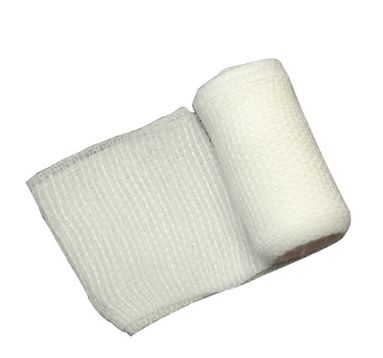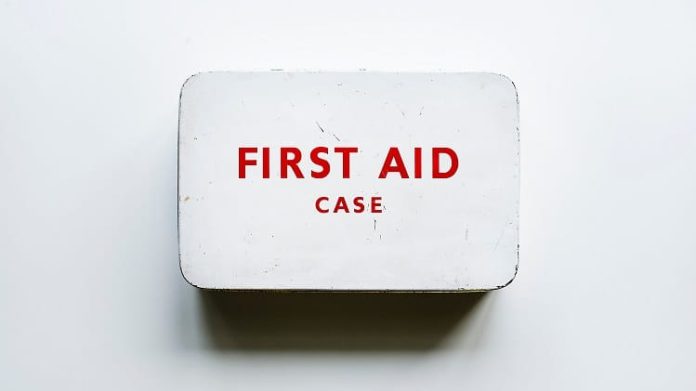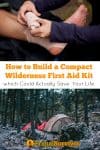I’ve looked at many bushcraft first aid kits, and, for the most part, I am disappointed by them.
There is almost always something missing from the first aid kit, or they are impractical (like being too big to carry).
This is scary when you think people rely on these first aid kits to help them survive in an emergency wilderness situation!
So I decided to make a guide about building the perfect bushcraft first aid kit, complete with everything you need to include.
The First Aid Bag
Let’s start with the first aid bag because this is what will hold everything and ensures the contents stay safe. Here are the main qualities you should look for in a wilderness first aid bag.
Waterproof
Imagine falling into a river and getting a big gash in the process. What good will those bandages do you if they are all wet? Your first aid bag must be waterproof! Most quality first aid bags will be waterproof, but some are poorly made and will leak around the zipper.
Puncture-Proof
The first aid bag should be sturdy so it won’t be torn or poked easily. This would allow water to get into the bag and compromise the contents.
Compact Size
A well-made and organized wilderness first aid kit for 4 people won’t need to be more than 6x8x1.5 inches. Save room in your Bug Out Bag for other crucial supplies!
Easy to Organize
If someone in your team is bleeding out, you don’t have time to waste searching for first aid items! Make sure the first aid bag has lots of pockets and organizational dividers so you can easily find items.
Download a copy of the wilderness first aid kit checklist.
These are the items we recommend for your list; the contents have been broken down into sections.
Trauma Items
Trauma means a significant injury that could threaten your survival or prevent you from moving. Some examples of traumas include knife wounds, other large wounds, or burns. The focus here is to stop the bleeding and prevent infection.
See our guide to the best trauma kits.
- Sterile heavy gauze (combine dressings): for applying pressure to wounds and removing excess blood
- Roller Bandages: These are used to hold a dressing in place or apply pressure over the wound to control bleeding
- Trauma pads: these are large, sterile pads for dressing deep wounds. They often have a blood clotting agent on them to reduce blood loss.
- Butterfly closures: for closing large wounds
- Wound stapler or suture kit: you shouldn’t try to suture wounds unless you are a medical professional, but in a Bug Out survival situation, you might not have any choice. A wound stapler is easier for untrained people than a suture kit. Read about the best suture kits here.
- Blood clotting agent: Known as “haemostatic agents,” they will help blood clot and reduce blood loss. You can buy some OTC.
- Tourniquet: A bandana will do and doubles as a sling. Note only use a bandana as a last resort: Multiple studies tell us that improvised tourniquets are often ineffective at best and can actually increase blood loss due to preventing venous blood return and essentially forcing even more blood out of the wound (not to mention causing massive damage to the underlying tissue due to being too narrow). For more on this, read how to use a tourniquet and best tourniquets for survival situations.
- Burn salve: Burns are a common wilderness injury, so you won’t want to forget this item. Petroleum jelly can be applied for minor burns, but you will want an antiseptic burn salve for more extensive burns.

Wound Care
- Nitrile gloves: You will need many pairs of these! Use a new pair of gloves each time you treat a wound.
- Tweezers: Used for removing debris from wounds
- Cotton tip swabs: Also used for removing debris from wounds, as well as debris stuck in the eyes
- Magnifying glass: Not absolutely necessary, but it can help you see small debris in wounds or splinters
- 60cc syringe with irrigation tip: For cleaning out wounds
- Antiseptic wipes: For cleaning surface wounds
- Small scissors: For cutting bandages
- Safety pins: Can be used to remove splinters or to secure bandages in place
- Antibiotic ointment or iodine: Apply to wounds before dressing
- Adhesive bandages (band-aids): Used for minor wounds; these are the most common types of wilderness injuries
- Non-adhesive sterile wound dressings: Lighter than the gauze/dressing used to control bleeding and clean wounds. They are applied to the wound. They are breathable to encourage healing but prevent dirt from getting through to the wound.
- Skin glue: This can be used to seal two sides of a wound together. It is suitable for minor, deep cuts.
- Moleskin: For protecting blisters. Pack lots of this because blisters will severely limit your mobility!
- Medical tape: For keeping dressings and bandages in place
* If you aren’t already familiar with them, I highly recommend you read this article about the different types of dressings and bandages!
Bone/Ligament Injuries
- Ace bandage: Please learn how to wrap an ace bandage, as sprains are very common wilderness injuries
- Triangle bandages: Think of triangle bandages as sterile bandanas. They can be used for absorbing blood, dressing head wounds, making an arm sling, or dressing large wounds. More on uses for a triangular bandage.
- Bendable Foam-Coated Splint: You can often fashion a splint out of found items, but this isn’t always the case – such as when you need a C splint for your thumb. Choose a small splint made from bendable aluminum and coated with foam.
Medications
- Antihistamine
- Insect bite cream
- Anti-diarrhea medicine
- Pain relievers
- Antibiotics
- EpiPen
- Antifungal cream
- Potassium Iodide: For thyroid blocking in a nuclear emergency
- Honey packets: Great for low blood sugar and giving quick energy when treating hypothermia
- Personal medications
Miscellaneous Items
You will also need a flashlight for performing first aid in the dark and scissors or a knife for removing clothing from around a wound. It is also helpful to have some sunscreen, lip ointment, and extra ziplock bags handy – but these are things you would keep in your survival backpack and not the first aid items.
Most importantly, ensure you know how to use all the first aid items! Take a first aid course, and include a first aid manual in your kit, just in case.
Are you prepared to survive a disaster?









